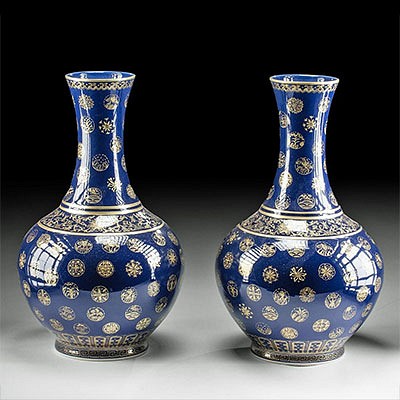Group of Chinese Ming Dynasty Shipwreck Porcelains
Lot 35b
About Seller
Artemis Fine Arts
686 S Taylor Ave, Ste 106
Louisville, CO 80027
United States
Selling antiquities, ancient and ethnographic art online since 1993, Artemis Gallery specializes in Classical Antiquities (Egyptian, Greek, Roman, Near Eastern), Asian, Pre-Columbian, African / Tribal / Oceanographic art. Our extensive inventory includes pottery, stone, metal, wood, glass and textil...Read more
Categories
Estimate:
$5,000 - $7,500
Absentee vs Live bid
Two ways to bid:
- Leave a max absentee bid and the platform will bid on your behalf up to your maximum bid during the live auction.
- Bid live during the auction and your bids will be submitted real-time to the auctioneer.
Bid Increments
| Price | Bid Increment |
|---|---|
| $0 | $25 |
| $300 | $50 |
| $1,000 | $100 |
| $2,000 | $250 |
| $5,000 | $500 |
| $10,000 | $1,000 |
| $20,000 | $2,500 |
| $50,000 | $5,000 |
| $100,000 | $10,000 |
| $200,000 | $20,000 |
About Auction
By Artemis Fine Arts
May 6, 2021
Set Reminder
2021-05-06 10:00:00
2021-05-06 10:00:00
America/New_York
Bidsquare
Bidsquare : Art of Asia | Antiquity to Present
https://www.bidsquare.com/auctions/artemis-gallery/art-of-asia-antiquity-to-present-6908
Featuring antiquities and works of art ranging from the third millennium BCE to the present. From West to East including the Near East and Central Asia, China, Japan, Korea and South and Southeast Asia. Including jades, bronzes, lacquer, textiles, paintings, prints, sculpture, ceramics, more! Artemis Fine Arts info@artemisgallery.com
Featuring antiquities and works of art ranging from the third millennium BCE to the present. From West to East including the Near East and Central Asia, China, Japan, Korea and South and Southeast Asia. Including jades, bronzes, lacquer, textiles, paintings, prints, sculpture, ceramics, more! Artemis Fine Arts info@artemisgallery.com
- Lot Description
Far East, China, found in the Philippines, ca. 16th century CE. This is a group of porcelain from a a Ming period Chinese shipwreck off the coast of Busuanga, Philippines. It contains a large porcelain platter with a blue on white orchid design and two bowls with blue and white floral motifs on the interiors and exteriors. There are also Sanskrit characters on the bowl, which would have been a symbol of Buddhism. These were found in 1997. Ming Dynasty China (1368 to 1644) is known as one of the longest periods of social and and governmental stability in human history. During this time period, China's was the great naval power of the East, with technology that surpassed anything that Europe had yet developed; this was the time of Zheng He and China's role as an international trader from the Mediterranean to the south Pacific. As the Ming period progressed, and the political conditions that had held the overland Silk Route together deteriorated, a Maritime Silk Road became more important to Chinese trade. Interestingly, many of the elements of these porcelains -- which would have been produced in China, under the control of the Imperial Court maintained Bureau of Design that ensured uniform standards in the production of ceramics -- had been inspired by Islamic art from further west trading opportunities. These come with two beautiful wooden stands for the small bowls. Size: Platter is 12-1/2" diameter x 2-1/2" H (32 cm x 6 cm); bowls are 5-3/4" diameter x 3" H (15 cm x 8 cm). Published in Arts of Asia, Volume 28, Number 3, May/June 1998: 76-88.
Provenance: Ex-private Northern Colorado collection, ex-Orientations Gallery, San Francisco, under the authority of the National Art Museum of the Philippines.
All items legal to buy/sell under U.S. Statute covering cultural patrimony Code 2600, CHAPTER 14, and are guaranteed to be as described or your money back.
A Certificate of Authenticity will accompany all winning bids.
We ship worldwide and handle all shipping in-house for your convenience.
#110425There are only tiny chips and cracks on these pieces; although the blue is slightly faded from centuries under the sea, the designs are very clear. There is a slight patina and the markings where barnacles were in small places, but this adds to the authenticity of the pieces.Condition
- Shipping Info
-
All shipping is handled in-house for your convenience. Your invoice from Artemis Gallery will include shipping calculation instructions. If in doubt, please inquire BEFORE bidding for estimated shipping costs for individual items.
-
- Buyer's Premium



 EUR
EUR CAD
CAD AUD
AUD GBP
GBP MXN
MXN HKD
HKD CNY
CNY MYR
MYR SEK
SEK SGD
SGD CHF
CHF THB
THB
















